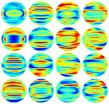(Press-News.org) This news release is available in German.
Material scientists at ETH Zurich and the Max Planck Institute of Colloids and Interfaces in Potsdam have developed a new type of sensor that can measure carbon dioxide (CO2). Compared with existing sensors, it is much smaller, has a simpler construction, requires considerably less energy and has an entirely different functional principle. The new sensor consists of a recently developed composite material that interacts with CO2 molecules and changes its conductivity depending on the concentration of CO2 in the environment. ETH scientists have created a sensor chip with this material that enables them to determine CO2 concentration with a simple measurement of electrical resistance.
The basis of the composite material is a chain-like macromolecule (polymer) made up of salts called ionic liquids, which are liquid and conductive at room temperature. The name of the polymers is slightly misleading as they are called «poly(ionic liquid)s» (PIL), although they are solid rather than liquid.
Unexpected properties
Scientists worldwide are currently investigating these PIL for use in different applications, such as batteries and CO2 storage. From their work it is known that PIL can adsorb CO2. "We asked ourselves if we could exploit this property to obtain information on the concentration of CO2 in the air and thereby develop a new type of gas sensor," says Christoph Willa, doctoral student at the Laboratory for Multifunctional Materials.
Willa and Dorota Koziej, a team leader in the laboratory, eventually succeeded by mixing the polymers with specific inorganic nanoparticles that also interact with CO2. By experimenting with these materials, the scientists were able to produce the composite. "Separately, neither the polymer nor the nanoparticles conduct electricity," says Willa. "But when we combined them in a certain ratio, their conductivity increased rapidly."
Chemical changes in the material
It was not only this that astonished the scientists. They were also surprised that the conductivity of the composite material at room temperature is CO2-dependent. "Until now, chemoresistive materials have displayed these properties only at a temperature of several hundred degrees Celsius," explains Koziej. Thus, existing CO2 sensors made from chemoresistive materials had to be heated to a high operating temperature. With the new composite material, this is not necessary, which facilitates its application significantly.
Exactly how the CO2-dependant changes in conductivity were produced is not yet clear; however, the scientists have found indications that a chemical change induced by the presence of CO2 occurs foremost at the interface between the nanoparticles and the polymers at the nanometre scale. "We think that CO2 effects the mobility of the charged particles in the material," says Koziej.
Breathing gauges for scuba divers
With the new sensor, scientists are able to measure CO2 concentration over a wide range - from a concentration of 0.04 volume percent in the earth's atmosphere to 0.25 volume percent.
Existing devices that can detect CO2 measure the optical signal and capitalise on the fact that CO2 absorbs infrared light. In comparison, researchers believe that with the new material much smaller, portable devices can be developed that will require less energy. According to Koziej, "portable devices to measure breathing air for scuba diving, extreme altitude mountaineering or medical applications are now conceivable".
INFORMATION:
Literature reference
Willa C, Yuan J, Niederberger M, Koziej D: When Nanoparticles Meet Poly(Ionic Liquid)s: Chemoresistive CO2 Sensing at Room Temperature. Advanced Functional Materials 2015, 25: 2537-2542, doi: 10.1002/adfm.201500314
Jackson Laboratory researchers have shown that using an electric current to deliver the CRISPR/Cas9 system, in order to engineer genetic changes in laboratory mice, is highly efficient and significantly improves the system's throughput.
CRISPR/Cas9 has significantly enhanced the precision, speed and ease with which experimental organisms can be genetically modified in order to create models of human diseases. Mice carrying mutations in single or multiple genes or other modifications can be created in one step by injecting the CRISPR/Cas9 system into zygotes (the cells ...
Metabolism experts are increasingly convinced that obesity and many of the pathogenic changes it entails, such as Metabolic Syndrome and type 2 diabetes, are a result of chronic inflammatory processes in fatty (adipose) tissue. The adipose tissue of obese people exhibits higher-than-normal quantities of almost all types of immune and inflammatory cells.
"We are quite convinced that immune cells play a role in the pathogenic consequences of obesity," says Professor Hans-Reimer Rodewald of the German Cancer Research Center (Deutsches Krebsforschungszentrum, DKFZ). "But ...
Scientists have discovered a trigger that allows breast cancer cells to spread to the lungs.
They have found that blocking the signals in mice with breast cancer greatly reduces the number of secondary tumours found in the lungs.
The findings could lead to new therapies that stop the progression of breast cancer, the researchers at the University of Edinburgh say.
The majority of deaths from breast cancer are caused by the tumour spreading to other parts of the body. The lung is often one of the first organs to be affected.
Researchers at the University's MRC Centre ...
NEW YORK (June 8, 2015) - Whole genome sequencing can quickly isolate the specific strain of bacteria causing an outbreak, identify the source of contamination, and enable rapid infection prevention to stop the spread of infection, according to a study published today. The findings, based on the examination of an outbreak of Pseudomonas aeruginosa in an Australian neonatal unit, appear in Infection Control & Hospital Epidemiology, the journal of the Society for Healthcare Epidemiology of America.
"Bacteria, such as P. aeruginosa, have evolved into many strains and frequently ...
WASHINGTON, June 8, 2015 -- With Caitlyn Jenner's recent transition in the news, more attention is being paid to the transgender community. A big part of gender transition is hormone replacement therapy (HRT). This week, Reactions talks about the chemistry of HRT and what happens when the body undergoes major shifts in estrogen and testosterone -- two very powerful hormones. Check it out here: http://youtu.be/l5knvmy1Z3s.
Subscribe to the series at http://bit.ly/ACSReactions, and follow us on Twitter @ACSreactions to be the first to see our latest videos.
INFORMATION:
The ...
WASHINGTON -- A new way of rapidly identifying bacteria, which requires a slight modification to a simple microscope, may change the way doctors approach treatment for patients who develop potentially deadly infections and may also help the food industry screen against contamination with harmful pathogens, according to researchers at the Korea Advanced Institute of Science and Technology (KAIST) in Daejeon, South Korea.
Described this week in The Optical Society (OSA) journal, Optics Express, the new approach involves bouncing laser light off individual bacteria under ...
SAN FRANCISCO (June 8, 2015) -- Scientists from the California Academy of Sciences are celebrating World Ocean's Day with a slew of brand new marine discoveries--more than 100 species that are likely new to science. The Philippines is home to the most biologically diverse waters on Earth, and remains the centerpiece of the Academy's multi-year exploration of the Coral Triangle's biological treasures. Over the course of this seven-week undertaking, funded by the National Science Foundation, scientists collected countless marine specimens, including rare and new species of ...
Bistatic/multistatic SAR has attracted global attention and made remarkable progress recently. Many key techniques have been overcome. Aiming to grasp the developing trend of the bistatic/multistatic SAR, the corresponding special issue has been compiled and published on SCIENCE CHINA Information Sciences, no. 6, 2015, which is devoted to integrate the key techniques together such as bistatic imaging, interferometry, change detection and the experiment with high quality etc.
The modified Stolt map in the frequency domain was introduced in the bistatic imaging algorithm ...
The train control system is the heart of Chinese high-speed railways, which is a core technology to ensure safe operation as well as high throughput of trains (see Figure 1). The correctness of the train control system is closely related to people's life and property. How to guarantee the correctness of train control system is a grand challenge in both software engineering and control theory. Recently, a group of Chinese researchers proposed an approach to verify the correctness of train control system by combining simulation and formal verification, which was published ...
New research from Uppsala University shows promising progress in the use of stem cells for treatment of spinal cord injury. The results, which are published in the scientific journal Scientific Reports, show that human stem cells that are transplanted to the injured spinal cord contribute to restoration of some sensory functions.
Traffic accidents and severe falls can cause ruptures of nerve fibers that enter/exit the spinal cord. Most commonly, these avulsion injuries affect the innervation of the arm and hand, and lead to paralysis, loss of sensation and cause chronic ...



